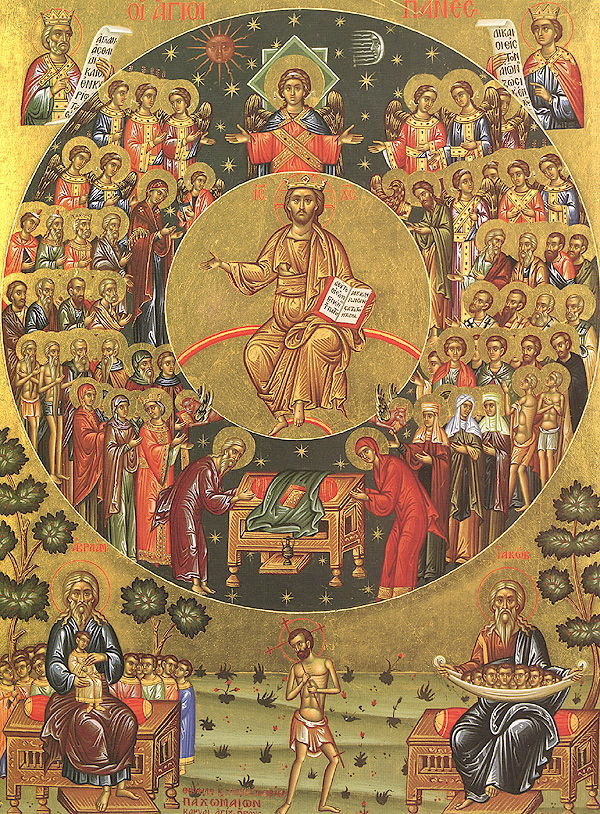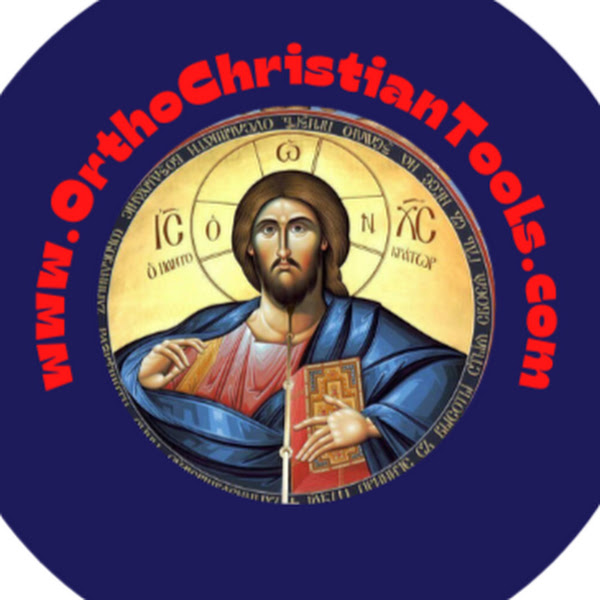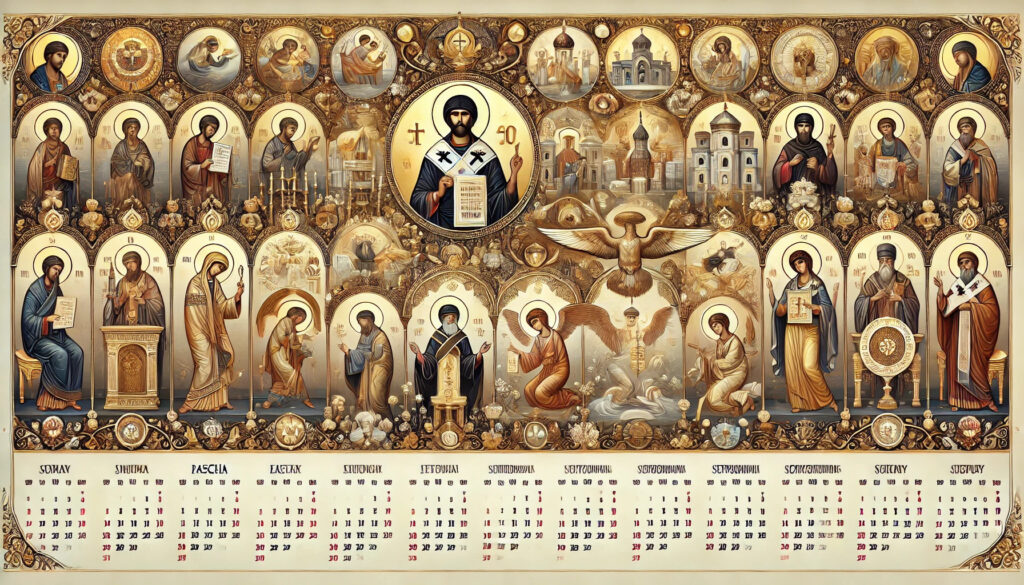The Orthodox Christian faith is deeply rooted in its sacred traditions, with the liturgical calendar serving as a spiritual roadmap that guides believers through the year. Each feast is not merely a commemoration but a living participation in the divine mysteries, offering opportunities for spiritual growth, repentance, and joyous celebration. From the radiant triumph of Pascha to the humble beginnings of the Theotokos’ life, these feasts form a continuous cycle of grace that nourishes the soul.
The Feast of Feasts: Holy Pascha (Easter)
Celebrated: Variable date (between April 4 and May 8 on Gregorian calendar)
The Historical and Spiritual Significance
Pascha stands as the pinnacle of Orthodox worship, the “Feast of Feasts” that gives meaning to all other celebrations. The events surrounding Christ’s Resurrection are meticulously preserved in Church tradition:
The Descent into Hades
Between His burial and resurrection, Christ descended into Hades, breaking the gates of death and liberating the righteous of the Old Testament. This profound mystery is celebrated in the stirring Paschal Homily of St. John Chrysostom.
The Myrrhbearing Women
Mary Magdalene, Mary the mother of James, and Salome came to anoint Christ’s body at dawn, demonstrating remarkable courage and devotion. Their faithful witness makes them the first evangelists of the Resurrection.
The Empty Tomb
The stone was rolled away not to let Christ out, but to reveal the empty tomb to the disciples. The carefully folded burial cloths (John 20:7) testified to the orderly nature of His resurrection.
Paschal Traditions and Theology
The Midnight Service: Beginning in complete darkness, the church is gradually illuminated as the priest carries the Paschal flame singing “Come receive the light!”
The Paschal Greeting: “Christ is Risen!” / “Indeed He is Risen!” is exchanged for 40 days.
The Red Eggs: Symbolizing both the tomb and new life, their red color represents Christ’s blood.
The Resurrectional Troparion: “Christ is risen from the dead, trampling down death by death, and upon those in the tombs bestowing life!”
The theological depth of Pascha is captured in the Kontakion: “Though You descended into the grave, O Immortal One, You destroyed the power of Hades…”

The Twelve Great Feasts
1. Nativity of the Theotokos (September 21)
The birth of the Virgin Mary marks the dawn of salvation history. Church tradition preserves details about her parents, the righteous Joachim and Anna:
Their childlessness in old age was seen as a reproach, yet they remained faithful.
An angel announced Mary’s conception, prefiguring the Annunciation.
At three years old, she was dedicated to God in the Temple (celebrated separately on December 4).
The feast’s hymns emphasize Mary as the “living ladder” connecting heaven and earth, foreshadowing her role as Theotokos (God-bearer).
2. Exaltation of the Holy Cross (September 27)
This feast commemorates two events:
The Discovery of the Cross (326 AD)
St. Helen, mother of Constantine, found the True Cross in Jerusalem after extensive excavations.
A miracle confirmed its authenticity when it healed a dying woman.
The Return from Persia (628 AD)
After the Persians captured the Cross, Emperor Heraclius returned it to Jerusalem.
Liturgical Features:
The Cross is solemnly elevated in church while the faithful sing “Lord, have mercy” 100 times.
Strict fasting is observed, reminding us of the Cross’s sacrificial nature.
3. Entrance of the Theotokos into the Temple (December 4)
At age three, Mary was brought to live in the Temple, where:
She was raised in prayer and purity, fed by angels according to tradition.
This event symbolizes her preparation to become the living Temple of God.
The hymnography compares her to the “Holy of Holies” and “spiritual paradise.”
4. Nativity of Christ (January 7)
The Incarnation of God is celebrated with profound theological depth:
Historical Context:
The census of Quirinius (Luke 2:2) places the event in historical time.
The humble cave-stable contrasts with Christ’s divine glory.
Theological Significance:
The Kontakion proclaims: “Today the Virgin gives birth to the Transcendent One…”
The star represents divine guidance, leading both Magi and all humanity to Christ.
Traditional Observances:
The Christmas Fast (November 15-December 24) prepares believers.
In Slavic tradition, Holy Supper on Christmas Eve features twelve Lenten dishes.
5. Theophany (January 19)
Christ’s baptism reveals the Holy Trinity:
The Father’s voice: “This is My beloved Son”
The Spirit descending as a dove
Christ the Son being baptized
Great Blessing of Water:
This “Great Agiasma” (holy water) is used throughout the year for blessings.
The prayers recall Christ’s sanctification of all creation.
6. Meeting of the Lord (February 15)
Forty days after Christmas, Christ is presented in the Temple:
Simeon’s prophecy: “A sword will pierce your soul” foreshadows Mary’s sorrows.
Anna the Prophetess represents faithful expectation of the Messiah.
This feast bridges Nativity and Pascha, showing Christ as “Light of the Gentiles.”
7. Annunciation (April 7)
The incarnation begins with Mary’s free consent:
Archangel Gabriel’s greeting becomes the basis of the “Hail Mary” prayer.
Mary’s response (“Let it be to me according to your word”) models perfect obedience.
This feast sometimes falls during Lent, when the fast is relaxed for fish, wine and oil.
8. Transfiguration (August 19)
On Mount Tabor, Christ reveals His divine glory:
Moses and Elijah represent the Law and Prophets bearing witness to Christ.
The bright cloud signifies God’s presence (Exodus 24:16).
Peter’s desire to build booths reflects human attempts to prolong mystical experiences.
Fruit Blessing:
Grapes (or other local fruits) are blessed, symbolizing the transformation of all creation.
9. Dormition (August 28)
The “Falling Asleep” of the Theotokos:
Tradition holds that all apostles were miraculously gathered for her departure.
After three days, her body was assumed into heaven.
The feast combines sorrow at her passing with joy at her glorification.
Dormition Fast (August 1-14):
A strict fast prepares believers for this “Summer Pascha.”

Movable Great Feasts
10. Palm Sunday
Christ’s triumphal entry fulfills Zechariah’s prophecy (9:9):
The people’s “Hosanna!” will soon turn to “Crucify Him!” showing human fickleness.
Willow branches (in Slavic tradition) represent renewal and resurrection.
11. Ascension (40 Days After Pascha)
Christ’s bodily ascension confirms:
His divine nature
The promise of our own glorification
The opening of heaven to humanity
The Troparion proclaims: “You ascended in glory, O Christ our God…”
12. Pentecost (50 Days After Pascha)
The Holy Spirit’s descent marks the Church’s birthday:
The tongues of fire reverse Babel’s confusion (Genesis 11).
Kneeling prayers are reintroduced after the Paschal period.
Other Major Feasts
Protection of the Theotokos (October 14)
Commemorating a 10th century miracle in Constantinople:
The Theotokos appeared in Blachernae Church, spreading her veil (omophorion) over the people.
This symbolizes her constant intercession for the faithful.
Synaxis of the Archangels (November 21)
Honoring the celestial hosts:
Michael: The great captain
Gabriel: Messenger of the Incarnation
Raphael: The healer
Uriel: The enlightener
Theological and Spiritual Significance
These feasts form a theological whole:
Christological: All feasts ultimately point to Christ’s saving work.
Mariological: The Theotokos’ role in salvation is emphasized.
Eschatological: Each feast anticipates the Kingdom to come.
As St. Gregory of Nyssa taught, the liturgical year is a “school of virtue” that trains believers in holiness through cyclical remembrance and participation in the mysteries of faith.
Conclusion
The Orthodox feasts are not merely historical commemorations but living encounters with divine grace. Through their proper observance – in fasting, prayer, and participation in the services – believers are gradually transformed, becoming “partakers of the divine nature” (2 Peter 1:4). As we journey through the liturgical year, we are reminded that “the Word became flesh and dwelt among us” (John 1:14), and continues to dwell in His Church through these holy celebrations.

